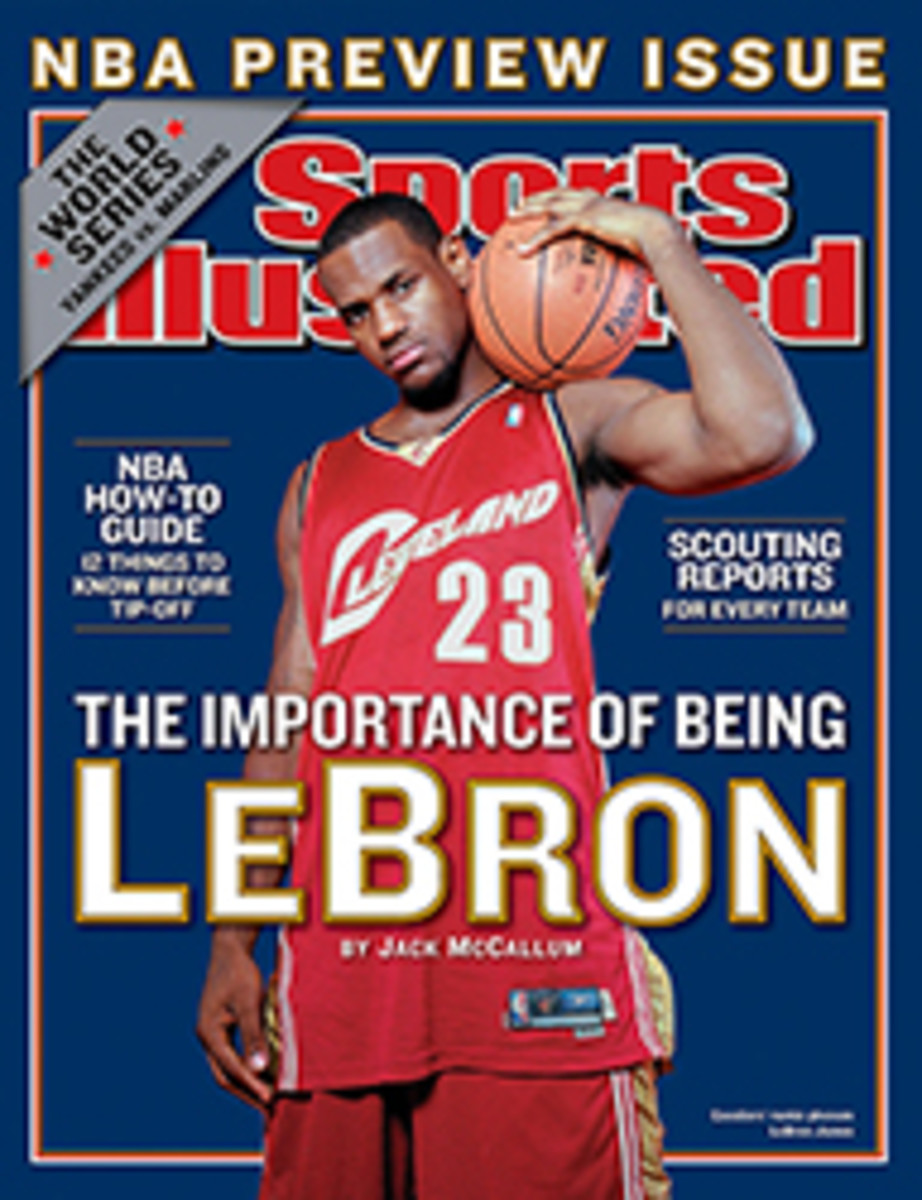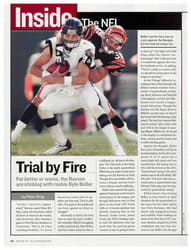
Hollywood Ending After a star turn in Seabiscuit and a real-life brush with death, Gary Stevens is riding high again
The last thing Gary Stevens saw as he lay on the turf was a
horse's hoof coming toward his face, first as a shadow and then
as a bludgeon. Seconds earlier Stevens and his mount, Storming
Home, had seemed in control of the Arlington Million, a
1 1/4-mile turf race at Arlington Park, outside Chicago on Aug.
16. They had begun to circle the field at the mile pole and
charged to the lead in midstretch, a perfectly timed rush by a
fit racehorse and a gifted rider working as one. Twenty yards
from the finish they were a length ahead when Storming
Home--apparently startled--bolted to his right, across the grass
and directly into the path of three other horses. Stevens held
on desperately, but when Storming Home crashed into the left
flank of Sulamani, Stevens fell to the ground in front of
Kaieteur, whose rider had no time to react. As Kaieteur
galloped over Stevens, the fallen jockey felt himself engulfed
by a sudden warmth. This is it, he thought. I'm a dead man.
It would have been some epitaph. HALL OF FAME JOCKEY. HOLLYWOOD
ACTOR. And the headlines: SEABISCUIT STAR DIES LIKE JOCKEY HE
PORTRAYED. The obituary would have told of his farm-boy roots in
Idaho and his rise to become one of the greatest riders in
history. "One of those riders--and you can count them on one
hand--who you don't even give instructions to," says trainer Bob
Baffert. There would have been mention of the 40-year-old
Stevens's three Kentucky Derby wins, his eight Breeders' Cup
victories. But mostly, it would have recounted the last 18
months, when he became one with a distant and now suddenly
popular history.
It happened like this: On the day of the Santa Anita Derby in
April 2002, Gary Ross, the writer-director of the movie
Seabiscuit, and Frank Marshall, the co-producer, came to the track
in search of a jockey to play George Woolf, the swashbuckling
1930s rider who lived fast and died young on the racetrack. One
glimpse at Stevens's looks and swagger and Ross said to Marshall,
"That's him." Though Stevens at first resisted--"Pal, you don't
have enough money, and I don't have enough time," he told Ross
that day--it was a better match of novice actor and role than
Ross could have imagined.
Stevens was a student of Woolf's long before Seabiscuit. He held
his 25th birthday party in Woolf's old apartment above The Derby,
a restaurant in the shadows of Santa Anita Park. "He liked a good
time, but he was cool and calculating on the racetrack," says
Stevens. "I understood the guy." In many ways, his life mirrors
Woolf's: Both rode on despite career-threatening health problems
(Woolf, severe diabetes; Stevens, arthritic knees that forced him
to retire in 2000, though he returned nine months later after
discovering an effective medication), both were heavy for jockeys
and kept a plug of chewing tobacco in their cheek. Both sat
chilly and confident in the saddle, and out of it.
The day after Stevens brushed off Ross, Stevens's manager, Ed
Goldstone, explained to his client that Ross was the creative
mind behind such movies as Big and Pleasantville, and that he was
making a Hollywood feature based on Laura Hillenbrand's best
seller, Seabiscuit. After having dinner with Ross in Louisville
before the 2002 Kentucky Derby, Stevens decided to sign on. "I
was wrong on both counts about Gary Ross," Stevens says. "They
had more than enough money, and I made more than enough time."
Stevens worked for four months on the movie, sharing the screen
with such A-list actors as Jeff Bridges, Chris Cooper and Tobey
Maguire. In his first scene Stevens bursts onto a set
representing the jockeys' room at Agua Caliente Race Course in
Mexico and interrupts an exaggerated tale being told by Maguire,
who plays jockey Red Pollard. Off camera, when the scene ended,
Maguire threw his arm around Stevens and whispered, soberly,
"Great job, buddy, but I gotta tell you, there's a little policy
that you don't upstage the star." Stevens was crestfallen, until
Maguire burst out laughing.
The movie has earned more than $119 million and picked up its
share of Oscar buzz. Stevens is now represented by high-powered
talent agency International Creative Management, which will sort
through acting offers that come his way, though he is not
currently signed for any projects. "He will have opportunities,"
says Ross. "It's not like we did movie magic in Seabiscuit and
made him look good. That was him up there. I got incredibly
lucky."
In Seabiscuit the story ends after Pollard wins one final race on
the Biscuit in 1940, skipping the sad epilogue six years later in
which the Iceman, as Woolf was known, dies at age 35 after
falling from a horse on the first turn at Santa Anita. "It wasn't
my goal to imitate that part of his life," says Stevens.
Yet at Arlington Park he nearly did. Approaching the finish line
that sun-dappled afternoon, he knew he was in trouble when
Storming Home began bearing out. "I remember thinking, Damn, I'm
going off! I'm going to cross the finish line in front, but I'm
going to get disqualified," recalls Stevens. "And when I hit the
ground, I couldn't cover up, and I figured I was going to get
killed."
As Kaieteur ran over him, it looked as if Stevens had been
stomped on the head. "Nasty, really nasty," says jockey Kent
Desormeaux, who was trailing the field on Olden Times. Stevens's
daughter, Ashley, 20, was sitting in freeway traffic in
California when her fiancee's father rang her cellphone to tell
her about the spill. She called her brother T.C., 19, "and he was
flipping out, thinking our dad was dead," says Ashley, the oldest
of Stevens's four children. In fact, Kaieteur's left front hoof
had grazed Stevens's left earlobe before landing solidly on his
neck and upper chest. It missed Stevens's temple but hit on the
side of his neck so hard that Stevens's gold necklace was
embedded in his skin. His chest was bruised, and his left lung
collapsed. On the ambulance ride to the hospital the pain was so
severe that Stevens thought he was having a heart attack. "It's
the first time I've feared for my life in an ambulance," he says.
"And I've been in a lot of ambulances." The lung was painfully
reinflated in the hospital. The bruises were allowed to heal on
their own. Stevens had been remarkably lucky.
Although Storming Home was first to the finish line in the
Arlington Million, he was disqualified. Then, on Aug. 24, Stevens
missed the Pacific Classic, at which he was to be aboard Candy
Ride, the unbeaten Argentine 4-year-old. Julie Krone got the
assignment, and just before the race Stevens met with her in the
Del Mar jockeys' room to advise her how to ride the horse. It was
a session reminiscent of the one in the movie in which Maguire
schools Stevens from his hospital bed before Seabiscuit's 1938
match race with War Admiral. "It was eerily similar," says Krone.
"The way Gary told me little things about the horse, and showed
so much confidence." Candy Ride won the race in a track record
1:59.11 for 10 furlongs.
Less than a week after his horrific spill Stevens was playing
Ping-Pong with the children of his agent, Craig O'Bryan. Twelve
days after the fall, he was working horses in the morning. And 19
days after feeling sure that he was about to be crushed, he rode
in a stake at Del Mar Race Course. On Sept. 28 he completed his
comeback by winning the Clement Hirsch Memorial Turf Championship
at Santa Anita aboard Storming Home. Stevens will ride Storming
Home again in Saturday's Breeders' Cup, also at Santa Anita, when
he expects to have a contender in nearly every race, including
Perfect Drift in the $4 million Classic.
To sustain such momentum, jockeys feel compelled to rush back
into action. Stevens has suffered for his livelihood, ignoring
injuries and fighting to keep his weight at 114 pounds or less
(he's 5'3"). "Everything you've heard about jockeys doing, I've
done," he says. "I've flipped [vomited intentionally], I've taken
diuretics." Only in recent years, with trainers willing to accept
a few extra pounds to get Stevens's skills, has he bumped his
riding weight up to 117. He has won more than $212 million in
purses (of which he gets the jock's customary 10%), and for
several years he has been entrenched as one of those rare jockeys
who earns his living primarily by jetting to big money races. A
suitcase sits half-packed in his living room at all times. "They
put you on a plane," he said not long ago, "and you go where the
money is." Stevens has a reputation for riding with uncommon
intelligence and cool amid the chaos of races, and early in the
morning, when trainers and owners build relationships with
riders, he works with an infectious smile and a sincere ear.
Suits and hardboots alike want him on their horses. "Gary may be
better off the track than he is in the saddle," says Desormeaux.
But when a jockey falls, he loses ground. "You're only as good as
your last 60 days," says Baffert. So for Stevens, a swift return
was fraught with complex emotions. Nearly getting killed might
have sent the message that it was time to become a full-time
actor, seizing on the opportunity afforded him by Seabiscuit, and
saying to hell with proving his fitness and nerves again. Yet
racing pulled him back. For now, acting will be an off-season
pursuit, and unless he is offered leading roles, racing will
remain far more lucrative. "The Arlington Million was a $1
million race. So was the Pacific Classic," says Stevens, sitting
on a wooden bench on the Del Mar backstretch. "I should have won
both, but I didn't, and that's $170,000 out of my pocket. My
agent loses 25 percent of that for his family, and then there are
the grooms back here that I take care of when I win a big race.
And don't forget all the people who bet on Storming Home."
"But forget about the money," says Stevens. "I love this sport,
and I always have. I'm grateful I've had the opportunity to do
this as long as I have." As if on cue, jockey "Cowboy" Jack
Kaenel shuffles past and shakes hands with Stevens. They go way
back, Kaenel having won the Preakness in 1982, when he was just
16, aboard Aloma's Ruler. He recently finished riding on the
California fair circuit, the bottom rung of the business. "I was
on the ground as much as I was on their backs," says Kaenel. They
share a laugh--a rider who is famous and one who used to be.
"Lately I've been saying, Why me? Why am I getting all these
opportunities?" says Stevens. "I don't know the answer, but I
know there's never been a time like this in my life." He is not a
dead man at all. In fact, he has never been more alive.
SI.com
Tim Layden's Viewpoint, every Friday at si.com.
COLOR PHOTO: PHOTOGRAPH BY ROBERT BECK BET ON IT Stevens, with Seabiscuit statue at Santa Anita, will ride several contenders in the Breeders' Cup.
TWO COLOR PHOTOS: FRANCOIS DUHAMEL/UNIVERSAL STUDIOS (2) CRITICS' CHOICE "It's not like we did movie magic and made him look good," says Ross (inset) of Stevens's film debut.
TWO COLOR PHOTOS: BRIAN KERSEY/AP (2) NO WAY OUT When his mount bolted to his right and hit another horse, Stevens fell in the path of the onrushing Kaieteur.
"I remember thinking, DAMN, I'M GOING OFF! When I hit the ground,
I couldn't cover up, and I figured I was going to get killed,"
says Stevens.

